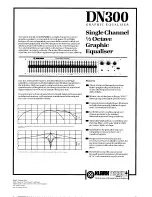
16
TUBE ULTRA-Q T1951
In complex sound reinforcement systems comprising different speakers located in varying acoustic
environments (e.g. theaters with front speakers, various side-fill speakers and/or balcony speakers) each
single time-delayed channel should be equipped with a separate TUBE ULTRA-Q, as this is the only way to
make provision for varying room acoustic and to adapt the speakers specifically.
What equalizers cant do
Equalizers are not a miracle cure for poor audio systems, but can be highly useful and efficient audio tools to
musically fine-tune such a system. Fine-tuning often delivers astounding results in terms of acoustic power
and overall sound quality. Equalizers are definitely the most important accessories of your audio system. They
can work wonders when they are used properly, just as the old saying goes:
Its the tone that makes the music!
4. TECHNICAL BACKGROUND
4.1 Function
Parametric equalizers represent the most advanced form of equalization systems. Basically, the user has
control over the three parameters that define the so-called Gaussian equalization curve: bandwidth, frequency
and amplitude boost/cut. Unlike graphic equalizers which provide a series of adjacent frequency bands to
approach a specific frequency, parametric equalizers allow for selecting a specific frequency directly. They can
be used to realize complex frequency curves with highest precision. Although the acoustic results of specific
equalizer settings cannot be predicted as easily as on graphic equalizers, parametric EQs are professional
audio tools of highest quality. It will certainly pay to invest some time to study their functioning principle and get
a feel for the way in which they can be used to modify the program material.
The newly developed UTC circuit provides subtle sound enhancement rather than showy effects processing. In
particular, digital workstations can be considerably enhanced in their sound character. You are free to use the
TUBE ULTRA-Q before the recording sessions or later when you mix down the music you recorded. You can
also use it to brighten up entire MIDI productions or even movie sound recordings and thus give them their
finishing touch.
Apart from the corrective function you can also use the TUBE ULTRA-Q as a creative tool. The TUBE ULTRA-Q
is an indispensable audio tool for application in recording studios, stage plays or radio dramas. You can use it
to distort voices, create telephone sounds and filter instruments to make them fit into the mixdown. All bands
are highly flexible with the possibility to achieve very narrow bands. In this respect the TUBE ULTRA-Q is
superior to a graphic equalizer.
4.2 The Constant-Q principle
One of the most important features any graphic or parametric equalizer has to offer is the independent control
of its various parameters. The special state-variable filters of the TUBE ULTRA-Q use the so-called
Constant-Q principle which prevents the parameters frequency, bandwidth and amplitude from
influencing each other. In the same way, the mutual influence of the individual frequency bands is avoided,
which is a fundamental requirement as it allows for clearly defined and repeatable filter settings. When several
filters are used simultaneously, the resulting overall filter curve can be calculated by adding/subtracting the
single band-specific filter curves.
4.3 The concept of parallel filters
Unlike conventional parametric equalizers the TUBE ULTRA-Q features a parallel filter configuration, which
offers a decisive advantage over series-type configurations: with parallel filters it is possible to reduce to a
minimum the phase shifts and delays usually associated with filters, which is the reason why the TUBE ULTRA-Q
is such a musical device.
Naturally, this concept, too, is subject to a few limitations: unlike series-type filter configurations the concept
of parallel filters allows only to a limited extent for an extreme boost/cut of frequencies. However, as extreme
settings are usually the result of an improperly adjusted sound image, it is imperative that deficiencies of this
4. TECHNICAL BACKGROUND
All manuals and user guides at all-guides.com
all-guides.com









































